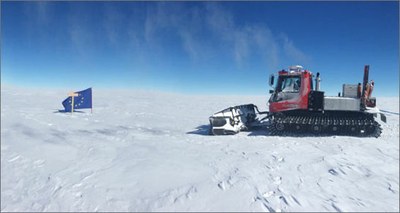Antarctica: The quest for the lost climate
4/7/2019
In one of the most extreme places on Earth, scientists will drill some 3,000m into the ice sheet to reconstruct ancient climate conditions
 It's called Little Dome C and is one of the coldest, driest and most lifeless places on Earth. But right here, within the Antarctic continent, scientists from all over Europe will come to study climate change, in this extreme place over 3,200 meters above sea level, where temperatures rarely rise above -25 ° C, and fall to -80 ° C in winter (seasons are opposite to ours). In fact, the European project "Beyond EPICA - Oldest Ice" has identified in this area, 40 km from the Italian-French base Concordia, the ideal spot for extracting ice cores, up to a depth of over 2.7 km, to look back at the Earth's climate for a million and a half years, when the glacial-interglacial cycle time was 40 thousand years and matched the regular oscillations of the angle of the terrestrial axis.
It's called Little Dome C and is one of the coldest, driest and most lifeless places on Earth. But right here, within the Antarctic continent, scientists from all over Europe will come to study climate change, in this extreme place over 3,200 meters above sea level, where temperatures rarely rise above -25 ° C, and fall to -80 ° C in winter (seasons are opposite to ours). In fact, the European project "Beyond EPICA - Oldest Ice" has identified in this area, 40 km from the Italian-French base Concordia, the ideal spot for extracting ice cores, up to a depth of over 2.7 km, to look back at the Earth's climate for a million and a half years, when the glacial-interglacial cycle time was 40 thousand years and matched the regular oscillations of the angle of the terrestrial axis.
"After three years of geophysical measurements and intermediate drilling, we chose this site because it has an undisturbed ice stratigraphy at least a million and a half years old: in every meter, in fact, at least 10-15 thousand years of climatic variations are recorded in the deepest layers, which we will study thanks to the analysis of greenhouse gases, such as carbon dioxide and methane, contained in the air bubbles trapped in the ice ", ENEA Glaciologist Massimo Frezzotti, Leader of the tracking expeditions at Little Dome C, explained .
In fact, thanks to the ancient small air bubbles trapped in the ice, climatologists can measure the concentrations of important greenhouse gases, finding a clear connection: in periods of colder climate CO2 and methane levels were significantly lower than in warmer periods.
"We have found that about 900 thousand years ago a significant change in the glacial-interglacial cycle time took place, going from 40 thousand to 100 thousand years. Paleo-climatologists know this phenomenon thanks to research on sediments that have accumulated on the ocean floor, but the only way to obtain direct data on the atmosphere of the past –such as the amount of CO2 and methane and the link between the presence of these gases and changes in climate- is analyzing the air bubbles contained in the ice core", Frezzotti pointed out.
After this first phase which has led to the identification of the site and once the European Union gives its go-ahead, a base camp will be set up at Little Dome C by the end of the year, while drilling activities are set to begin in November 2021 and end in February 2024. The first data will be available in 2025.
The activities for the identification of the site were conducted for Italy by ENEA, the INGV and the Universities of Bologna and Venice 'Cà Foscari,' as part of the National Antarctic Research Program (PNRA), implemented by the CNR for programming and scientific coordination and from ENEA for logistics.
